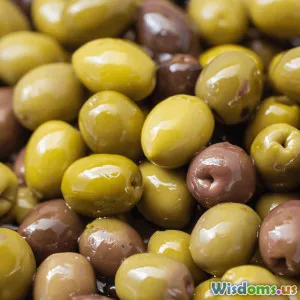
Five Ingredients That Can Transform Basic Pasta Dishes
7 min read Discover five game-changing ingredients that can elevate your basic pasta dishes to culinary masterpieces. (0 Reviews)
Five Ingredients That Can Transform Basic Pasta Dishes
Pasta is often celebrated as the ultimate comfort food: quick, versatile, and universally loved. But how often do we settle for the same simple tomato sauce or plain olive oil tossed pasta, missing out on the opportunity to elevate these humble dishes into extraordinary meals? The secret isn’t always in complex recipes or exotic sauces; it’s in a handful of transformative ingredients that add unexpected depth, persuasion, and refinement to your favorite pasta. In this article, we’ll explore five remarkable ingredients that can turn any basic pasta dish into a culinary triumph.
1. Anchovies: The Umami Powerhouse
At first mention, anchovies might evoke hesitation because of their intense flavor and saltiness. Yet, anchored in Italian culinary tradition, anchovies are magic for pasta sauce. Just a few finely minced or melted anchovy fillets can imbue a sauce with rich umami — the savory fifth taste that deepens complexity without overt fishiness.
Why use anchovies?
- They dissolve into the sauce, delivering salty richness.
- They enhance other ingredients like garlic, tomato, and herbs.
Example:
In the classic Italian sauce aglio e olio (garlic and oil), adding anchovies transforms the simple sauce into a balanced, deeply flavorful dish. Award-winning chef Massimo Bottura often references anchovies as an ingredient that takes dishes from ordinary to brilliant.
The beauty of anchovies lies in their invisibility: they enhance rather than dominate.
2. Toasted Nuts: Crunch and Earthiness
Texture plays a crucial role in culinary satisfaction, and many pasta dishes suffer from monotony when solely dependent on soft noodles and silky sauces. Incorporating toasted nuts such as pine nuts, walnuts, or almonds adds a delightful crunch and a layer of nutty earthiness.
Nuts in pasta:
- Toasted pine nuts complement pesto pasta, adding fragrant warmth.
- Crushed walnuts can enrich pumpkin or creamy pasta sauces.
- Toasted almonds brighten lemon or garlic-infused pasta with crunch.
Nutritional perks:
Nuts provide healthy fats, protein, and minerals like magnesium, making your pasta not only tastier but more nutritious.
Award-winning food writer Michael Pollan highlights how tiny sensory surprises like nuts can transform the eating experience. Toasting nuts undeniably releases their aromatic oils, elevating a dish’s overall profile.
3. Preserved Lemons: Punch of Brightness
Preserved lemons are salted, cured lemon rinds prevalent in North African and Middle Eastern cuisines. Unlike fresh lemon juice, preserved lemons offer a mellow, intense citrus brightness with savory complexity.
Why they work in pasta:
- Add subtle acidic brightness that keeps dishes lively.
- Introduce slight saltiness and unique fermented complexity.
- Pair beautifully with seafood, chicken, or herbaceous sauces.
Example:
Try mincing preserved lemon rind into olive oil and garlic-based sauces. Such a simple addition wakes up flavors, as chef Yotam Ottolenghi advocates using preserved lemons to bring dimension to Mediterranean dishes, including pasta.
4. Fresh Herbs (Beyond Basil): Layered Aromatics
Basil may be king in Italian pasta, but there's a world of fresh herbs ready to amplify your dishes’ aromatic and flavor profiles.
Hero herbs for pasta:
- Tarragon: Adds subtle anise notes, excellent in cream sauces.
- Mint: Provides fresh, cooling hints that contrast rich tomato sauces.
- Chervil: Delicate, slightly parsley-like, perfect for lighter pasta dishes.
- Chives: Offer a gentle onion-y flavor that sharpens simple buttered noodles.
Combining herbs can multiply the freshness; a mix of parsley, thyme, and oregano or cilantro blended with lime can add a unique twist where Italian merges with other cuisines.
Pro tip:
Add delicate herbs at the end of cooking to preserve their aroma. This finishing touch makes your pasta feel vibrant and freshly made.
5. High-Quality Cheese: The Final Flourish
Cheese is foundational to pasta, but the key is quality, variety, and correct application.
Cheese game-changers include:
- Pecorino Romano: Saltier and sharper than Parmesan; perfect in carbonara or vegetable-based sauces.
- Taleggio: A soft, washed-rind cheese with a fruity tang.
- Ricotta Salata: A firmer, salted ricotta excellent for grating or crumbling.
- Parmigiano-Reggiano: The classic nutty, rich cheese with complex umami notes.
Tips for cheese on pasta:
- Grate cheese freshly: pre-grated alters flavor and texture.
- Use cheese sparingly but confidently — it’s a seasoning, not a filler.
- Experiment with melting cheeses into sauces for creaminess.
At Osteria Mozza in Los Angeles, chef Nancy Silverton emphasizes the transformative power of precise cheese choices, noting how the right cheese can elevate fresh pasta textures and flavors exceptionally.
Conclusion: Rethink Your Pasta Pantry
Pasta's simplicity is its strength, but with just a handful of keenly chosen ingredients — anchovies, toasted nuts, preserved lemons, fresh nontraditional herbs, and premium cheese — you can reimagine even the most basic dishes into extraordinary plates.
Next time you boil noodles, think beyond the jarred marinara. Embrace these enriching ingredients to uplift your meals both in flavor complexity and eating pleasure. You’ll find that small tweaks can unlock infinite possibilities right from your kitchen.
Embark on this flavorful journey with confidence, curiosity, and a willingness to experiment, and you won’t look at pasta the same way again.
References:
- Bottura on anchovies: https://www.finedininglovers.com
- Pollan on texture and nuts: https://michaelpollan.com
- Ottolenghi on preserved lemons: https://www.ottilenghi.co.uk
- Silverton on cheese: https://osteriamozza.com
Rate the Post
User Reviews
Popular Posts





















